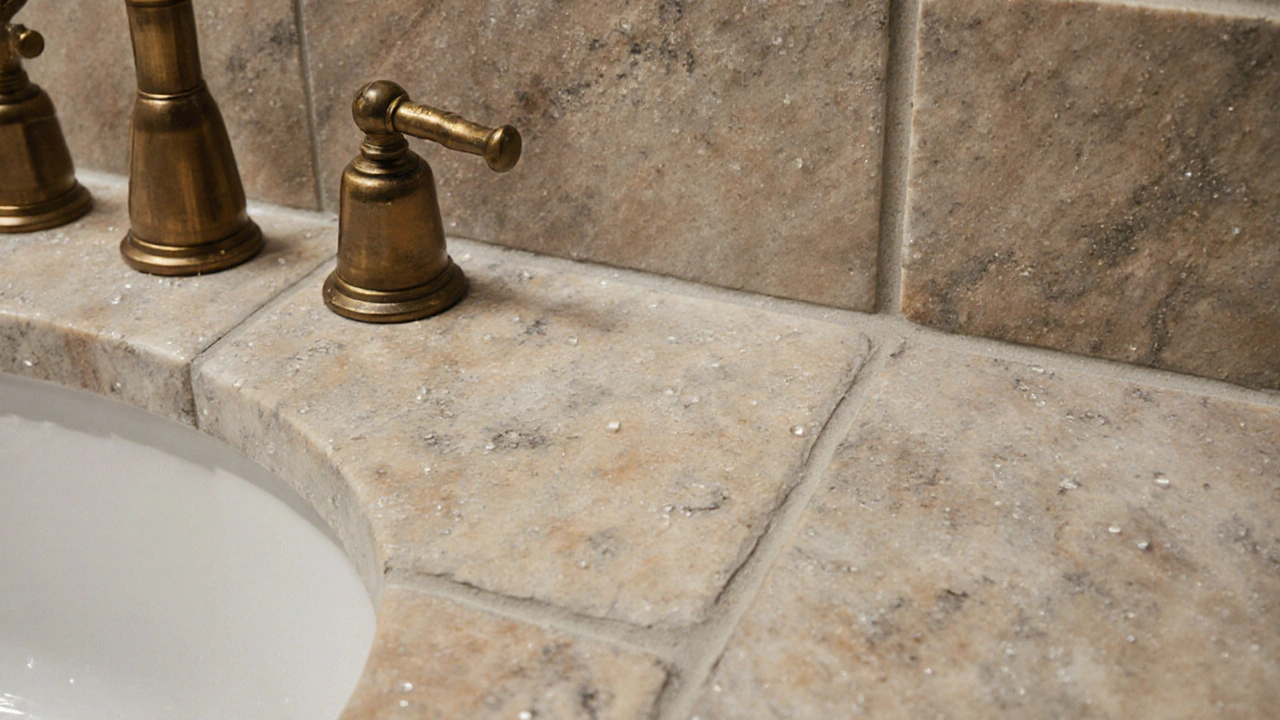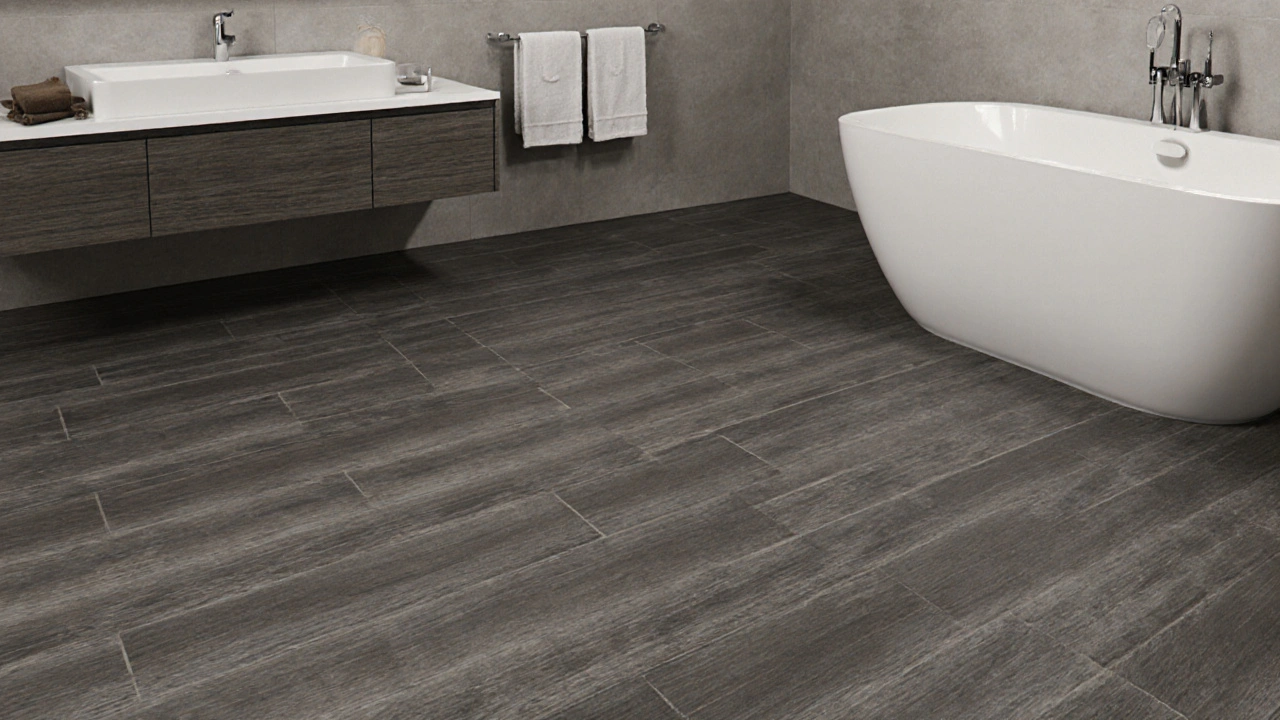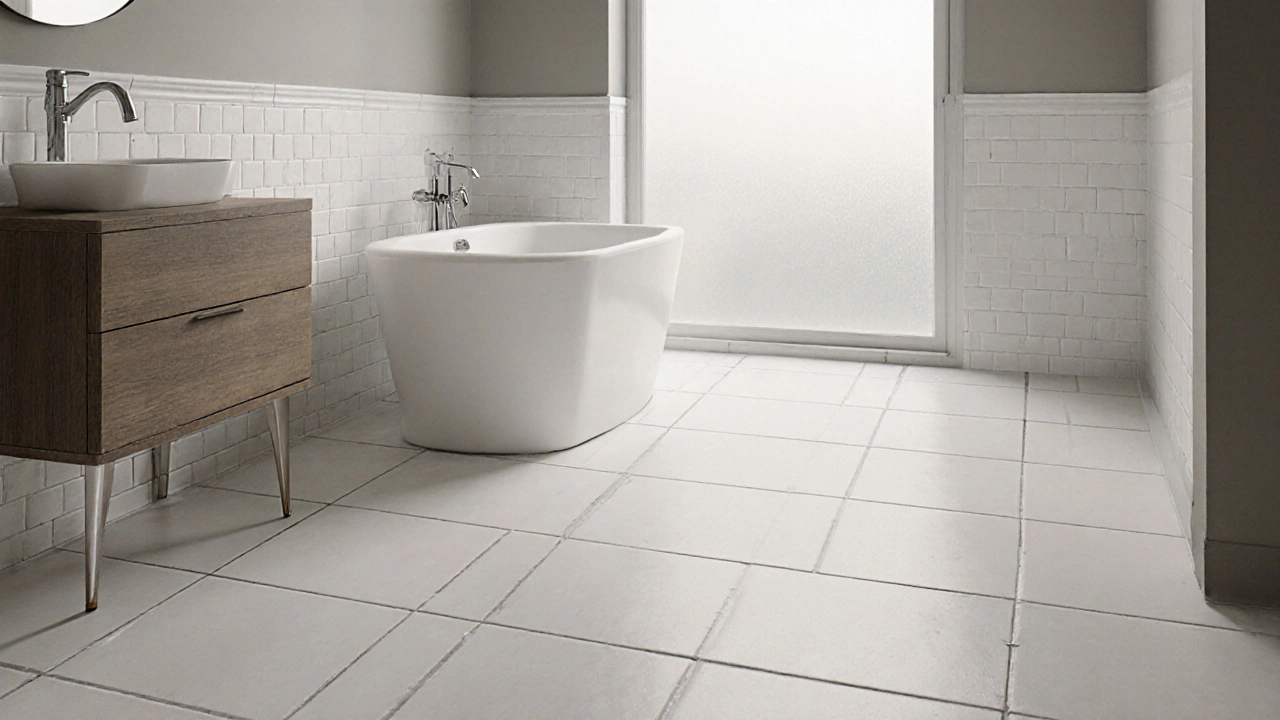When you remodel your bathroom, you don’t want to redo the floor in five years. You want something that looks good now, still looks good in 2030, and doesn’t scream "2025" when you sell your house. So what bathroom flooring is truly timeless? Not trendy. Not flashy. Not something that’ll look dated next to a white subway tile or a freestanding tub. The answer isn’t one material-it’s a handful of smart, proven choices that have stood the test of time, weathered moisture, survived family chaos, and still feel elegant decades later.
Porcelain Tile Is the Gold Standard
Porcelain tile isn’t new. It’s been around since the 1980s, and it’s still the top pick for bathrooms in homes built today. Why? It’s dense, waterproof, and nearly impossible to scratch. Unlike ceramic, porcelain doesn’t absorb water, so it won’t crack in freezing temperatures or warp under steam. You can find it in matte finishes that look like natural stone, in wood-look planks, or even in small hexagons that mimic vintage subway tiles.
Real homes in Burlington, Ontario, with porcelain tile installed in 2005 still look pristine. No fading. No grout stains that won’t clean. No peeling. One homeowner replaced her entire bathroom in 2007 with 12x24 inch matte white porcelain. She’s still using it. Her kids spilled paint, dropped soap dispensers, tracked in mud-nothing stuck. The grout? Re-sealed every three years, and it’s still clean. That’s durability with zero trendiness.
Porcelain tile also comes in colors that never go out of style: soft whites, warm greys, deep charcoals, and earthy beiges. Avoid glossy finishes unless you’re going for a retro look-they show water spots and footprints. Matte or textured finishes are the quiet winners.
Natural Stone: Quiet Luxury That Ages Gracefully
Marble, travertine, and limestone have been used in bathrooms since Roman times. They’re not cheap, but they’re not going anywhere. Marble, especially Carrara, has a soft, veined look that feels luxurious without being loud. It doesn’t scream "designer"-it whispers "old money."
Here’s the catch: natural stone needs sealing. Twice a year, at least. If you skip it, water gets in, stains show up, and the surface dulls. But if you maintain it? It develops a patina. That’s not wear-it’s character. A 20-year-old marble floor in a historic home in Toronto still looks better than most new installations because it’s been cared for.
Travertine is a smarter pick for high-traffic bathrooms. It’s less porous than marble and has a naturally textured surface that hides water spots. It’s warm underfoot, and its neutral tones blend with everything-from brass fixtures to modern vanities. You won’t find a travertine floor from 2010 that looks dated. You’ll find one that looks like it belongs in a boutique hotel.
Large-Format Porcelain Wood-Look Planks
Wood floors in bathrooms? Ten years ago, people laughed. Now? It’s everywhere. But real wood? Bad idea. Water warps it. Mold grows in it. That’s why wood-look porcelain planks are the quiet revolution.
These planks are made to look like oak, walnut, or teak-but they’re 100% waterproof. The texture mimics real wood grain. The color variations are subtle, not plastic-looking. And they’re installed like tile, so there are no gaps for water to sneak into.
Homeowners who switched from vinyl to wood-look porcelain in 2018 report the same satisfaction as those with real hardwood: warm, inviting, and quiet underfoot. But they don’t have to worry about a leaky faucet ruining the floor. The best part? They come in wide planks (7 to 9 inches) that reduce grout lines, making the space feel bigger and cleaner.
Choose a matte or hand-scraped finish. Avoid high-gloss wood-look tiles-they look fake. And stay away from red or yellow tones. Stick to greys, warm browns, and charcoal. Those are the colors that never age.

Why Vinyl and Laminate Don’t Make the Cut
Let’s be clear: vinyl plank and laminate are fine for a rental or a basement bathroom. But if you’re looking for timeless, they’re not it. Vinyl can fade under sunlight. The edges curl after five years. The patterns look repetitive-like wallpaper on the floor. Laminate? It swells if water gets underneath. You’ll see it in resale photos: peeling corners, discolored patches, and that weird plastic sheen.
There’s a reason you don’t see vinyl floors in 1970s homes that still look good. They weren’t built to last. Even the "luxury" vinyl options today are designed for a 10- to 15-year lifespan. Timeless means 30, 40, 50 years. Vinyl doesn’t get better with age. It just gets tired.
What About Grout? The Silent Killer
It’s not just the tile-it’s the grout. White grout in a bathroom? Looks beautiful. Until it turns grey. Then it looks dirty. And no amount of scrubbing fixes it. That’s why epoxy grout is the secret weapon of timeless bathrooms.
Epoxy grout doesn’t stain. It doesn’t need sealing. It’s waterproof from day one. It’s harder to apply, and it costs more, but it lasts. You won’t find a bathroom with epoxy grout from the 1990s that looks worn out. The grout lines are still crisp. The floor still looks clean.
If you’re going with traditional cement grout, go with a color that matches your tile. A light tile with light grout? That’s a recipe for dirt to show. Dark tile with dark grout? That’s invisible. Grey grout with charcoal porcelain? That’s the move.
Color Is Everything
Timeless doesn’t mean boring. But it does mean avoiding trends. That means no bold colors. No patterned tiles. No mosaic accents unless they’re subtle. The most enduring bathroom floors are neutral. Soft whites. Warm greys. Muted beiges. Deep charcoals. These colors don’t compete with the rest of the room. They let the fixtures, the lighting, the towels-everything else-shine.
One mistake people make? Choosing a floor that matches their vanity. That’s a trap. Vanities change. Fixtures change. Floors stay. Pick a floor that works with every possible color scheme. That’s why white porcelain with grey grout is the most common floor in homes that have been remodeled twice. It’s the silent backbone.

Installation Matters More Than You Think
Even the best material can fail if it’s installed wrong. Water needs to drain. The subfloor must be level. The tile must be set with proper thinset. Grout must be packed tight. If the installer skips the waterproof membrane under the tile? You’re asking for rot, mold, and a very expensive repair.
Always use a waterproof membrane like Schluter-DITRA or RedGard. It’s not optional. It’s insurance. In cold climates like Burlington, where pipes freeze and thaw, that membrane keeps the tile from cracking. It’s the invisible layer that makes your floor last.
And don’t go cheap on the installer. A bad job on porcelain tile can cost you $5,000 in repairs. A good one? It lasts 50 years.
What to Avoid
- Patterned tiles-especially florals or geometric designs from the 90s. They date fast.
- Dark, glossy tiles-they show every fingerprint and water spot.
- Small mosaic tiles-too many grout lines mean more cleaning and more failure points.
- Real hardwood-even engineered wood can warp in a steamy bathroom.
- Linoleum-it’s back in fashion, but it stains easily and fades in sunlight.
Final Thought: Timeless Isn’t About Price
You don’t need marble to have a timeless bathroom. You don’t need to spend $200 a square foot. Porcelain tile, properly installed, costs about $5-$10 a square foot. Add epoxy grout, and you’re still under $15. That’s less than luxury vinyl. But it lasts three times longer.
Timeless bathroom flooring isn’t about being fancy. It’s about being smart. It’s about choosing materials that don’t fight water, don’t fade under light, and don’t need constant attention. It’s about letting your bathroom feel calm, clean, and quiet-no matter what’s in style next year.
When you walk into a bathroom with a floor that’s 20 years old and still looks good, you don’t think, "Wow, this is trendy." You think, "This feels right." That’s the goal.
Is porcelain tile really the best choice for bathroom flooring?
Yes. Porcelain tile is the most reliable option for bathrooms because it’s waterproof, scratch-resistant, and doesn’t fade. It’s used in homes built over 40 years ago and still performs perfectly today. It’s also available in styles that mimic stone, wood, and concrete, so you get the look you want without the maintenance.
Can I use real wood in my bathroom?
Not recommended. Real wood, even engineered wood, can warp, swell, or rot from moisture and steam. Over time, water damage leads to mold and structural issues. Wood-look porcelain tiles give you the appearance of wood with zero risk.
What color should my bathroom floor be?
Stick to neutral tones: soft white, warm grey, beige, or charcoal. These colors blend with any vanity, fixture, or wall color and never look dated. Avoid bold colors like blue, green, or red-they become trendy and then quickly outdated.
How often do I need to reseal my bathroom floor?
If you’re using natural stone like marble or travertine, reseal it twice a year. If you’re using porcelain tile with epoxy grout, you never need to seal it. Cement grout should be sealed once a year, but epoxy grout is the better long-term choice.
Is epoxy grout worth the extra cost?
Absolutely. Epoxy grout doesn’t stain, doesn’t need sealing, and resists mold and mildew. It costs about 30-50% more than regular grout, but it lasts the lifetime of the tile. For a bathroom that’s used daily, it’s one of the best investments you can make.


Anand Pandit
November 12, 2025 AT 14:12Porcelain tile is the real MVP for bathrooms. I installed it in my condo back in 2016 and never looked back. No staining, no warping, even with two dogs and three kids. Matte finish with grey grout? Perfect. Zero maintenance beyond a quick mop. This is the kind of choice you thank yourself for in 10 years.
Reshma Jose
November 12, 2025 AT 20:12I used to think marble was the only way to go until my friend’s 1998 bathroom with travertine still looked like a spa. The key? Sealing it religiously. Twice a year, no excuses. It’s not hard, just consistent. And yeah, the patina? That’s not wear, that’s history. You can’t buy that kind of character.
rahul shrimali
November 14, 2025 AT 04:10Epoxy grout is the secret weapon forget about cement grout it’s a trap. I did my whole bathroom with it and never cleaned grout again. Worth every rupee. No mold no stains no drama. Just clean lines forever.
Eka Prabha
November 15, 2025 AT 06:53Let’s be honest this whole timeless flooring narrative is corporate propaganda. Porcelain is made in China. Epoxy grout is petroleum-based. Natural stone is mined by exploited labor. They’re selling you a fantasy of durability while ignoring the environmental and ethical cost. You think your floor lasts 50 years but what about the planet it came from? The real timeless choice is not installing anything at all.
Bharat Patel
November 15, 2025 AT 14:24There’s something deeply human about choosing materials that outlast trends. We’re not just picking floors we’re picking silence. A floor that doesn’t shout doesn’t demand attention. It just holds space. Porcelain doesn’t care if your vanity is chrome or brass. It doesn’t flinch when the steam rises. It just exists. And in a world of noise that’s the quietest kind of luxury.
Bhagyashri Zokarkar
November 17, 2025 AT 01:32ok so i did the wood look porcelain like 3 years ago and honestly i regret it a little like the texture is nice but it gets so slippery when wet and i almost died once and now my husband is always like dont walk barefoot and i just want to cry because i thought it was gonna be cozy but its just kinda dangerous and the grout is turning grey even though i sealed it and now i feel like a fool for spending so much on something that makes me anxious
Rakesh Dorwal
November 17, 2025 AT 07:09They say porcelain is timeless but did you know most of it is imported from countries that don’t even have proper labor laws? Why are we celebrating foreign-made tiles like they’re sacred? We have great clay here in India. Why aren’t we making our own? This isn’t about style this is about surrendering our self-reliance for a shiny floor.
Vishal Gaur
November 17, 2025 AT 23:06Look I get the porcelain thing but honestly I think people overhype it. I had it in my old place and sure it didn’t crack but the grout? Always looked dirty even with sealing. And the cold underfoot in winter? Brutal. I switched to luxury vinyl plank last year and honestly it’s warmer quieter and the wood look is way more realistic now. Yeah it might not last 50 years but neither will my marriage so why stress over the floor?
Nikhil Gavhane
November 19, 2025 AT 03:46I appreciate how practical this is. My mom’s bathroom from 1987 still has the same porcelain tiles. She never re-did it. Just cleaned it. That’s the beauty of it. It doesn’t need to be perfect. It just needs to be there. And it is. Quietly. Reliably. No drama. That’s more than most things in life can say.
Rajat Patil
November 19, 2025 AT 03:51I would like to respectfully suggest that the emphasis on durability should not overshadow the importance of comfort. While porcelain is excellent in longevity, it may not be ideal for elderly individuals or those with joint sensitivities. The addition of a soft, removable rug in key areas can enhance safety and warmth without compromising the timeless nature of the underlying material. A balanced approach is often the most thoughtful.
deepak srinivasa
November 19, 2025 AT 07:15If porcelain is so timeless why do we keep seeing new patterns every year? If it’s truly neutral why are there 50 shades of matte grey? Isn’t the obsession with avoiding trends just another trend? Maybe timeless isn’t about the material but about our relationship to it. Maybe the floor that lasts is the one we stop trying to control.
pk Pk
November 21, 2025 AT 01:52Guys if you’re thinking about doing your bathroom floor don’t overthink it. Porcelain tile. Matte finish. Grey grout. Epoxy if you can afford it. That’s it. No need for marble no need for wood look no need for fancy colors. You want to save time money and stress? This is your blueprint. I’ve helped 15 families do this and not one regrets it. Simple works.
NIKHIL TRIPATHI
November 22, 2025 AT 21:07I’ve been thinking about this a lot. The real reason porcelain works isn’t because it’s waterproof or scratch-resistant. It’s because it doesn’t try to be anything else. It doesn’t pretend to be wood. It doesn’t try to be marble. It just is. And in a world where everything is trying to be something else - a phone that looks like leather a car that mimics a spaceship - maybe the most radical thing we can do is choose something that simply endures without trying to impress. That’s not just smart. That’s peaceful.